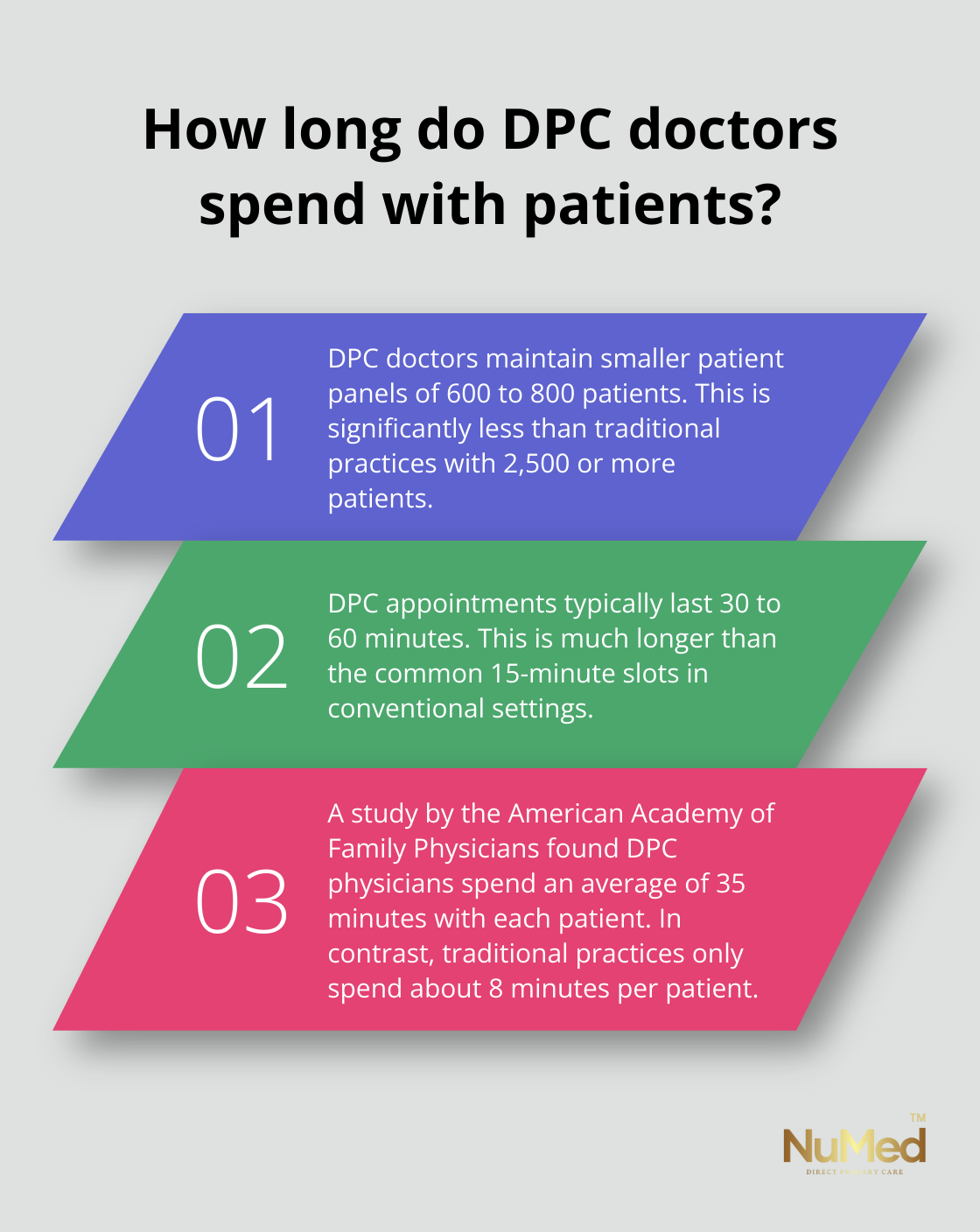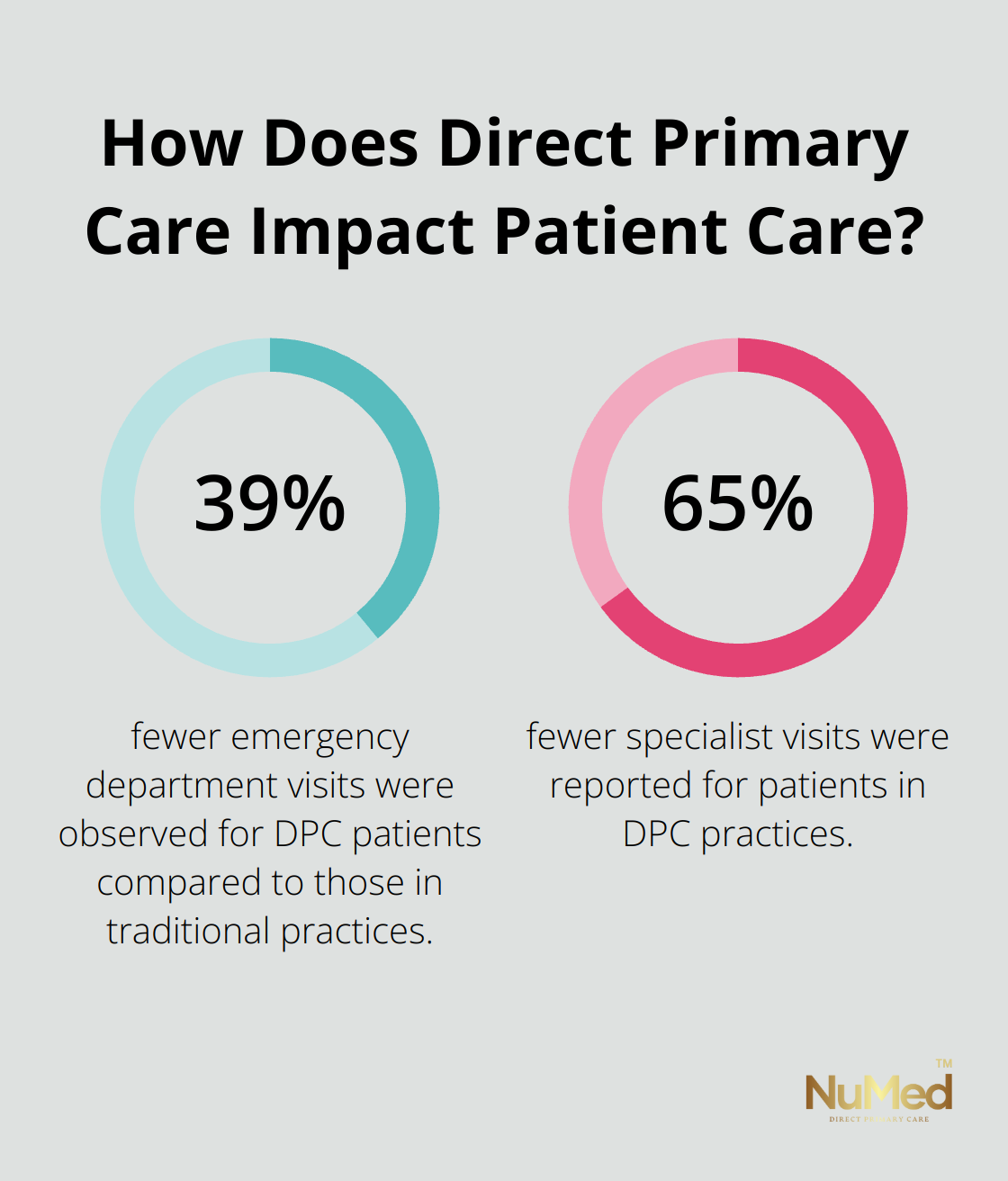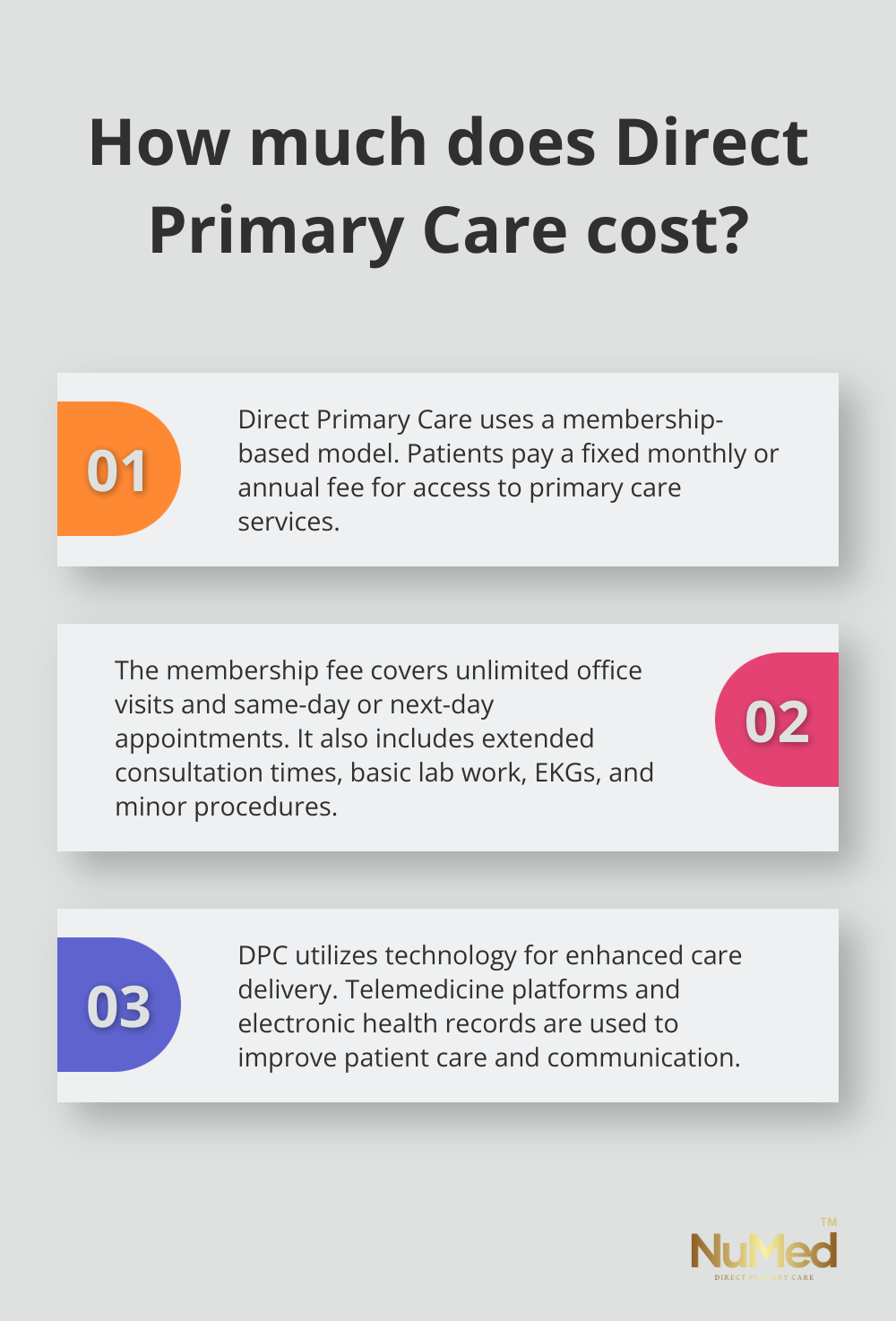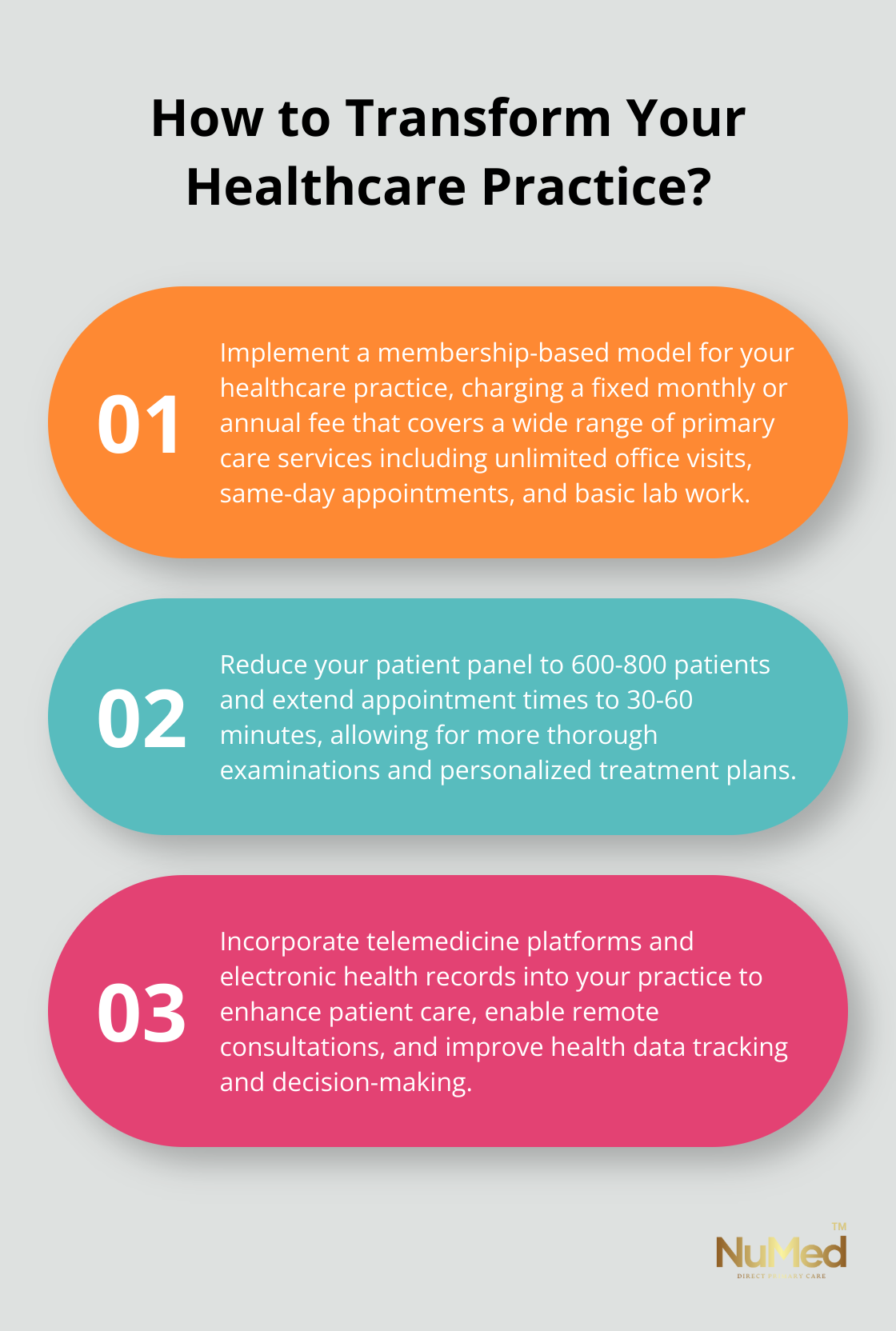At NuMed DPC, we’re often asked about the direct primary care definition and how it differs from traditional healthcare models. Direct Primary Care (DPC) is a revolutionary approach to healthcare that’s gaining traction across the United States.
In this blog post, we’ll explore the key concepts of DPC, its benefits, and how it works in practice. We’ll also discuss why more patients and doctors are embracing this innovative healthcare model.
What is Direct Primary Care?
A Revolutionary Healthcare Model
Direct Primary Care (DPC) revolutionizes healthcare by eliminating intermediaries, allowing patients to work directly with their primary care physician. This membership-based approach requires patients to pay a monthly or annual fee for access to a range of primary care services.
Smaller Patient Panels, Longer Appointments
DPC doctors typically maintain smaller patient panels (600 to 800 patients) compared to traditional practices (2,500 or more). This reduction enables longer appointment times, often 30 to 60 minutes, instead of the rushed 15-minute slots common in conventional settings.

A study by the American Academy of Family Physicians found that DPC physicians spend an average of 35 minutes with each patient, compared to just 8 minutes in traditional practices. This extra time allows for more thorough examinations, detailed discussions about health concerns, and the development of personalized treatment plans.
Freedom from Insurance Constraints
A key difference between DPC and traditional healthcare models is the absence of insurance billing for routine care. DPC practices don’t interact with insurance companies for primary care services, which eliminates a significant administrative burden.
Focus on Preventive Care and Wellness
DPC practices prioritize preventive care and overall wellness. With more time and resources available, doctors can address the root causes of health issues rather than just treat symptoms.
Many DPC practices offer comprehensive annual physicals, nutrition counseling, and lifestyle coaching as part of their membership. Some even provide classes on topics like stress management or healthy cooking, further supporting patients’ overall well-being.
This emphasis on prevention and early intervention aims to reduce the need for costly specialist visits and hospitalizations.
As we explore the benefits of Direct Primary Care in the next section, you’ll see how this innovative model transforms the healthcare experience for both patients and providers.
Why Direct Primary Care Transforms Healthcare
Direct Primary Care (DPC) revolutionizes healthcare by addressing many pain points in traditional systems. This innovative model prioritizes the patient-doctor relationship, offering a level of care often missing in conventional practices.
Unparalleled Access to Your Medical Provider
DPC provides enhanced access to care. Patients in DPC practices often enjoy:
- Same-day or next-day appointments
- Extended visit times
- Direct communication with their physician
A study by the Journal of the American Board of Family Medicine found that DPC patients had 39% fewer emergency department visits compared to those in traditional practices. This improved access leads to better health outcomes and fewer unnecessary hospital visits.
Substantial Cost Savings for Patients
DPC can result in significant cost savings. A report by the Society of Actuaries revealed that DPC members experienced 25.54% lower hospital admissions compared to non-DPC patients. This reduction in hospitalizations (combined with the absence of copays and deductibles for primary care services) can result in substantial financial benefits for patients.
Personalized Care Plans That Work
The DPC model allows for truly personalized care. With more time and fewer patients, DPC physicians can thoroughly examine each patient’s health history, lifestyle, and goals. This comprehensive approach often leads to more effective treatment plans.

A study published in the Journal of Health Economics found that patients in DPC practices had 65% fewer specialist visits. This indicates that their primary care physicians were able to address a wider range of health issues effectively.
Advanced Diagnostic Tools and Services
DPC practices often incorporate advanced diagnostic tools and offer a broader range of services under one roof. This might include:
- In-house lab testing
- Minor procedures
- Some specialist consultations
These additional services reduce the need for referrals and additional appointments, streamlining the healthcare process for patients.
As we explore how Direct Primary Care works in practice, you’ll see how this innovative model continues to reshape the healthcare landscape, offering a more patient-centered, cost-effective, and comprehensive approach to primary care.
How Direct Primary Care Operates
Membership-Based Model
Direct Primary Care (DPC) transforms traditional healthcare through a membership-based approach. Patients pay a fixed monthly or annual fee for access to a range of primary care services.
Comprehensive Care Package
The membership fee covers a wide array of services, including:
- Unlimited office visits
- Same-day or next-day appointments
- Extended consultation times
- Basic lab work
- EKGs
- Minor procedures
Technology-Enhanced Care
Technology plays a key role in enhancing the DPC experience:
- Telemedicine platforms allow patients to consult with doctors via video calls or secure messaging
- Electronic health records (EHRs) enable better tracking of patient health data and more informed decision-making
Specialized Care and Emergency Management
DPC physicians act as coordinators and advocates when patients require specialized care or face emergencies:
- Established relationships with specialists facilitate quicker referrals
- 24/7 access to physicians via phone or text helps triage emergency situations

Final Thoughts
Direct Primary Care (DPC) transforms healthcare by redefining the patient-doctor relationship and prioritizing preventive care. This innovative model provides comprehensive primary care services without traditional insurance constraints, allowing for longer appointments and personalized care plans. The direct primary care definition emphasizes a membership-based approach that offers same-day access and tailored healthcare solutions.

DPC’s impact on the healthcare landscape could lead to more patient-centered care, reduced costs, and improved health outcomes. Patients who consider DPC should evaluate how this model aligns with their healthcare needs and budget, assessing the scope of services offered by DPC practices. It’s important to weigh the benefits of enhanced access to care against the monthly membership fee.
At NuMed DPC, we provide compassionate, holistic healthcare that addresses the root causes of illness and promotes overall wellness. Our comprehensive approach to primary care includes extensive lab services, functional medicine, and health coaching. Patients who choose DPC experience a healthcare model that puts their needs first, fostering a strong partnership between patient and practitioner for better health outcomes.
















